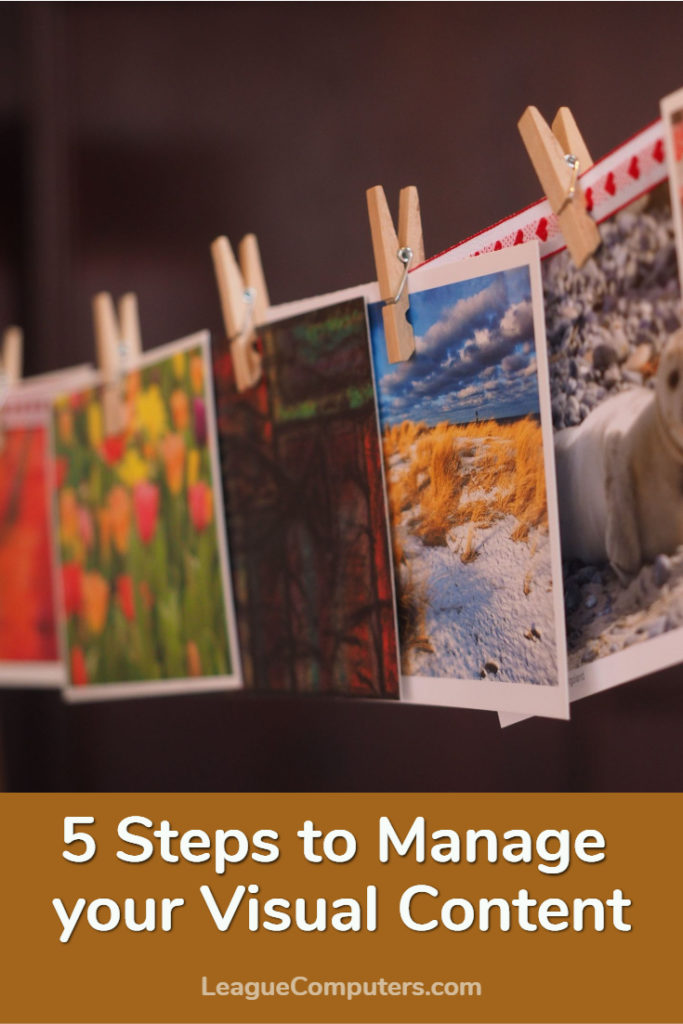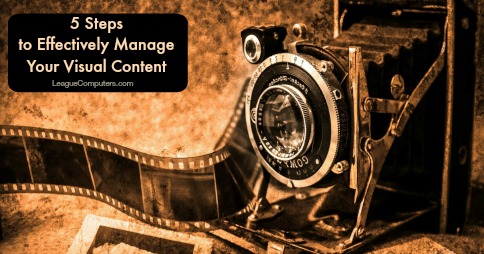Visual content is more important than ever to your social media strategy, and you don’t want to be left behind…but for a small business owner or solo-preneur, all this visual content can become another overwhelming part of a complicated social media plan.
So how can you handle the visual content necessary for social media success? The following 5 steps will help you more effectively manage the photos, videos, Infographics, etc., that your small business needs to create and promote.
Step 1. State the purpose of your visual content
Visual content is becoming a bigger part of everyone’s content marketing strategy, but why should your business use it?
Are you using videos to convert prospects into customers?
Do you want to create Infographics on industry statistics for business branding?
Does your target audience like short, how-to videos on topics related to your products/services?
Know the purpose of each piece of visual content you create, and you’ll be less likely to waste resources later.
Step 2. Determine your available resources
Whether you have in-house staff or plan to outsource visual content creation, figure out lead time, turnaround time, etc. so you know how long it takes to get the finished product.
If you are a one-man or one-woman show in your small business, then the most important thing is to figure out how much time it takes you to create visual content. Then, you’ll need to figure out how to schedule that time into your (already) busy schedule.
You may use a combination of resources for creating visual content:
- You use a professional photographer for headshots/website photos, and a graphic designer for logo/brand images.
- You (or your staff) create the more day-to-day, casual photos/videos.
Don’t forget that you can ask your community for visual content – photos of favorite desserts at your restaurant for example – and then post those shots (with a unique hashtag) on your social sites.
Your resources will probably also include other people’s photos (free or paid), so it’s a good idea to find a few reliable sites now.
A few of my favorites for free images include Pixabay, PhotoPin, and MorgueFile, but there are many others.
Check out this fantastic collection of free image sites from the BufferApp blog: https://blog.bufferapp.com/free-image-sources-list
Step 3. Set up a schedule to create (or organize) your content
In the same way that you set aside regular times for writing and blogging, there should be time in your calendar for creating your visual content (or organizing it, if you outsource the content creation).
While smartphones make it easy to snap photos on the spur-of-the-moment, taking a photo every now and then that you share on Instagram is not the long-term visual content strategy you should adopt.
Focus on an overall schedule for your visual content, like:
- Monthly product demo videos of customer favorites or current specials
- Weekly behind-the-scenes photos of your business and/or employees
- Periodic video testimonials or photos of happy customers
Then consistently create batches of content for each goal or cateogory. If you create visual content in batches – spend an hour and take 10 photos of your business/employees behind-the-scene – then you can use each photo in a different post over the next several weeks or months.
And think of those spontaneous smartphone photos or videos as some nice “extras” in your overall visual content strategy.
Step 4. Put a plan in place to promote it
How many pieces of original visual content will you be creating each week?
What social sites will you be sharing the content on?
If the content is also on your website (which is recommended, as you should make your website the “hub” of your content), how will you send traffic to your site?
Answer these questions and then plan a promotion schedule for your visual content – the same way you promote a blog post.
Step 5. Set up a smart system to save time
One of my personal goals this year is to spend more time re-purposing and recycling content. Let’s face it: with so much content already out there, and the challenges in reaching every Follower on a regular basis, your online community won’t see a lot of your content the first time around.
So don’t make your promotion of your visual content a one-time campaign.
With each piece of content you create, plan for at least 2 ways to re-purpose it, and set up a system to re-post or re-cycle it.
For example, on my personal blog and related social sites, I share daily inspirational image quotes. I’ve spent time creating a new image quote every day for the past year…so I now have 365 image quotes on my computer.
I can re-post them this year (how many of my fans/followers will remember if they saw it last year?) or I can re-purpose them (I can put 10 of these image quotes into a Slideshare or a video as a new piece of visual content).
Another example is a system for videos:
Are you planning on using videos in your marketing strategy this year?
Create a short, weekly video of evergreen content (content that will be relevant several months from now).
Promote a new video each week on your website and your social sites. Later on, put a group of these short videos together into one long video or a free video series (for email list-building).
You can also start re-posting the original videos on your social sites after 3-6 months for your new followers.
As small business owners create more visual content, we’re quickly going to get overwhelmed by it! So use these steps now to set up a few systems and a plan to more effectively manage your photos, videos, presentations, and Infographics.

Need some help creating a strategy for your visual content? Let’s chat! We offer a Free Consultation to answer any questions and recommend the next, best steps for your business. Contact us now to set up a day and time!


